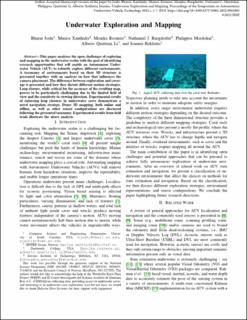| dc.contributor.author | Joshi, Bharat | |
| dc.contributor.author | Xanthidis, Marios | |
| dc.contributor.author | Roznere, Monika | |
| dc.contributor.author | Burgdorfer, Nathaniel J. | |
| dc.contributor.author | Mordohai, Philippos | |
| dc.contributor.author | Quattrini Li, Alberto | |
| dc.contributor.author | Rekleitis, Ioannis | |
| dc.date.accessioned | 2023-06-27T12:28:10Z | |
| dc.date.available | 2023-06-27T12:28:10Z | |
| dc.date.created | 2023-03-07T16:52:00Z | |
| dc.date.issued | 2022 | |
| dc.identifier.citation | Proceedings of the Symposium on Autonomous Underwater Vehicle Technology. 2022, 1-7. | en_US |
| dc.identifier.issn | 1522-3167 | |
| dc.identifier.uri | https://hdl.handle.net/11250/3073499 | |
| dc.description.abstract | This paper analyzes the open challenges of exploring and mapping in the underwater realm with the goal of identifying research opportunities that will enable an Autonomous Underwater Vehicle (AUV) to robustly explore different environments. A taxonomy of environments based on their 3D structure is presented together with an analysis on how that influences the camera placement. The difference between exploration and coverage is presented and how they dictate different motion strategies. Loop closure, while critical for the accuracy of the resulting map, proves to be particularly challenging due to the limited field of view and the sensitivity to viewing direction. Experimental results of enforcing loop closures in underwater caves demonstrate a novel navigation strategy. Dense 3D mapping, both online and offline, as well as other sensor configurations are discussed following the presented taxonomy. Experimental results from field trials illustrate the above analysis. | en_US |
| dc.language.iso | eng | en_US |
| dc.publisher | IEEE | en_US |
| dc.title | Underwater Exploration and Mapping | en_US |
| dc.title.alternative | Underwater Exploration and Mapping | en_US |
| dc.type | Journal article | en_US |
| dc.type | Peer reviewed | en_US |
| dc.description.version | acceptedVersion | en_US |
| dc.rights.holder | ©2022 IEEE | en_US |
| dc.source.pagenumber | 1-7 | en_US |
| dc.source.journal | Proceedings of the Symposium on Autonomous Underwater Vehicle Technology | en_US |
| dc.identifier.doi | 10.1109/AUV53081.2022.9965805 | |
| dc.identifier.cristin | 2132068 | |
| dc.relation.project | National Science Foundation: 1943205, 1919647, 2024741, 2024541, 2024653, 2144624 | en_US |
| dc.relation.project | Norges forskningsråd: 327292 | en_US |
| cristin.ispublished | true | |
| cristin.fulltext | original | |
| cristin.qualitycode | 1 | |
